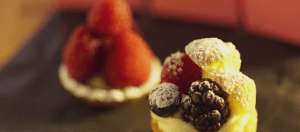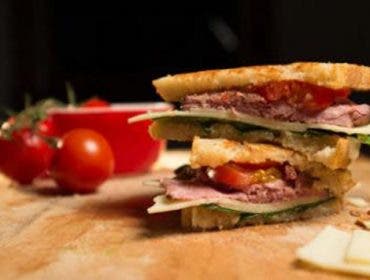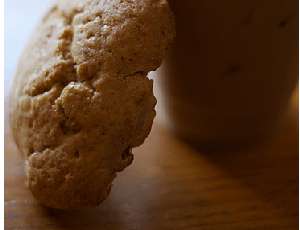A behind-the-scenes look at a food photography shoot—and a lesson in being flexible and willing to change plans at the last second.
I have a regular photography client—Sushiana, a Sushi restaurant in Central New Jersey—and whenever they add new items to their menu, they call me in to do food photography. They’re doing well—they recently moved from their original hole-in-the-wall location to spacious new digs (including a huge kitchen). To celebrate, they expanded the menu to include faux meat pan-Asian main dishes, all made, convincingly, with Soy-based fake meats. They also hired a dessert chef, and expanded their dessert menu.
My assignment? Simple: Make it all look delicious…even for carnivores.
My pop-up studio included a couple of wireless flashes, a reflector, and assorted light modifiers. I set up with the restaurant’s “living wall,” consisting of dozens of plants, in the background.
I would photograph mock Kong Pao Chicken, fake Beef Moo Sho, and imitation Pad Thai Shrimp. And, of course, Chocolate Mousse. A casual consumer might not realize the fake meats weren’t the real thing, even after eating the dishes. It’s amazing what judicious use of sauce can do to food!
I arrived at the restaurant at 11AM, before the lunchtime crowd would arrive. I set up a work space in a corner of the office, using the just-planted “living wall”—a focal point of the new space that would help identify the images as unique to the restaurant’s new location—as the background.
My workspace before the shoot. Note the two transluscent windows. They would come into play soon. Photo © Mason Resnick
I brought my lighting kit—a couple of Canon 550s (predecessors to the currentCanon Speedlite 600EX-RT) powered byFlashpoint Blast Power Pack BP960s as well as a Canon 430 EX II—a32-inch Glow reflector (I would use the silver surface), a Glow HexaPop 24-inch light box, and a couple of 33-inch Adorama shoot-through umbrellas—along with my trusty workhorseCanon 5D Mark III and Canon 60mm f/2.8 macro lens. I’d operate the flashes wirelessly in Manual mode via the Canon ST-E2 Speedlite Transmitter. This setup gives me lots of options and full control over the light and exposure.
Oodles of Noodles, lit with the above setup. Note the living wall in the background—a deliberate choice since it’s a distinctive aspect of this eatery’s decor. Nice and clear.Photo © Mason Resnick
Except, I ended up not needing them for every shot.
At first, I lit and photographed about a dozen dishes, and they looked great. But at about 1:00 p.m., the sun started to shine intensely through the big translucent windows lining the south side of the restaurant, adjacent to where I was working. The light was soft and pleasing, and the live preview image looked amazing. I turned off the flashes, moved them out of the way, reset the tripod-mounted camera for a long exposure, and shot away.
The initial batch of photos were evenly lit from above, and looked quite good. This photo of sweet and sour mock chicken with broccoli is a typical main dish close-up done at f/16 and ISO 200. There’s some focus fall-off, but my goal was to show as much detail as possible. Photo © Mason Resnick
Where’s the beef? This is Mock Beef with Stir Fried Veggies! Photo © Mason Resnick
The result? I made a draconian decision to go natural.
At the old location, such a coincidence wouldn’t have been possible. The restaurant was a simple storefront, with one big north-facing window. In that situation, I needed to produce all the light myself. But with the sun streaming through here, I decided to treat the rest of the shoot as a natural-light setup. Fortunately, the owner trusts my instincts and when I told him my plan to use the beautiful lighting (and showed him what I was seeing on screen in live view), he said “go for it.”
At first, I shot this dish (sorry, don’t know the name, but there’s some kind of fish involved) with my full flash rig. The details are good, but…
When I turned off the lights and got the reflector to bounce the window light to my liking, I got this. Yes, depth of field is more shallow, but the ethereal lighting and good focus fall-off added up to a more dramatic photo. Which would you choose? Photos © Mason Resnick
The staff and owner crowded around my camera and oohed and ahhed. (Even the dessert chef looked at the picture and said, “nice Bokeh”) I held the silver reflector up to each dish, and adjusted position enough to kick light into the shadows and give the subject added dimension.
For the rest of the shoot, I worked this way: First, I shot with the flashes firing as before, for the sake of consistency. Then, I turned off the ST-E2 transmitter thereby deactivating the flashes. I created a custom exposure setting of 1/20 sec at f/3.5, adjusted the reflector, and shot a few variations. I provided the customer with both versions so he could choose.
Since I was now shooting longer exposures and smaller apertures at close distances, focus was critical. I no longer trust autofocus in such situations, and while I have 20-20 vision when wearing glasses, there is still too much room for error. So, when I photograph food (or, for that matter, any still-life subject) I switch to manual focus and use enlarged Live View. On the Canon, that means pressing the “+” button twice for a 10x enlargement. I can pinpoint the exact area of the photo that I want to be in focus, then fine-focus while in enlarged live view. This leaves nothing to chance.
Finally, there was dessert: This chocolate mousse was one of the last dishes that I photographed (and would promptly devour when we were done, so I can attest that it was delicious). First, I photographed it under the flash setup. It came out OK but could I do better? Photo © Mason Resnick
Then, following my new procedure, I turned off the flash and shot it in natural light. Now it was mouth-watering! By the way: It may look like I applied vignetting in post-processing, but I didn’t. That’s the way the light fell! (The dessert chef, looking over my shoulder at the preview in the LCD, said “hey, nice bokeh”!) Photo © Mason Resnick
The results looked great (and tasty). The owner couldn’t be happier, and is preparing to add them to his web site.
The moral of the story? Be prepared to be in full control of the light…but if something better comes along, don’t be afraid to change your strategy.
And the best part for me? I got to take out what I photographed, and now have a freezer full of delicious Asian culinary fakery.





